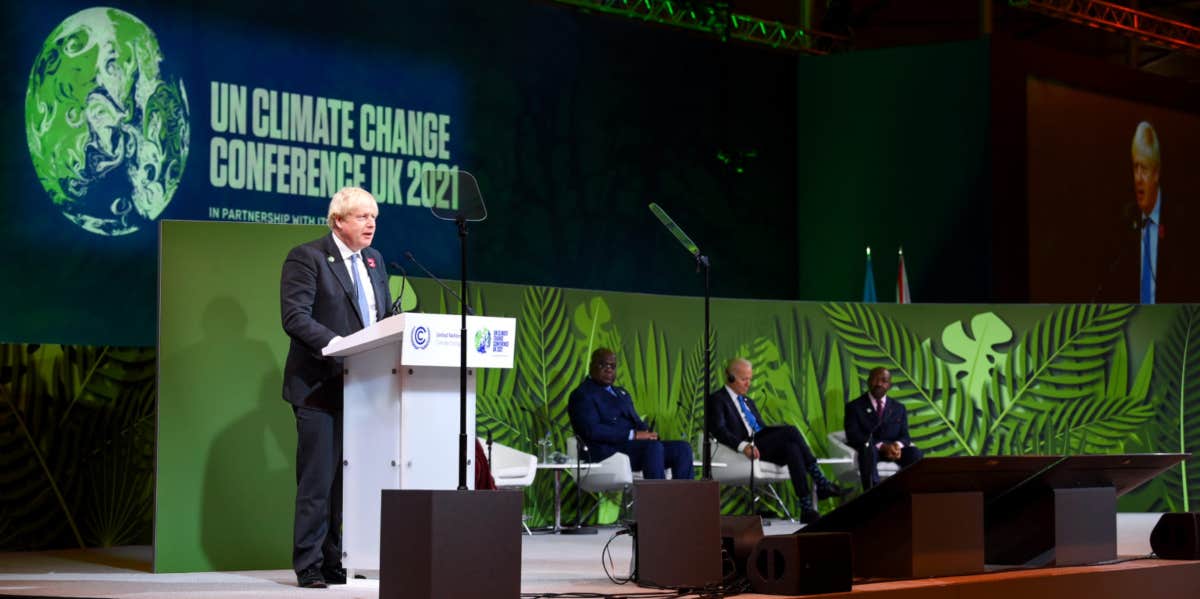COP26 Summit Is Serving Meals With A Carbon Footprint 7 Times Higher Than Climate Agreement Recommendations
They had one job.
 UK COP26
UK COP26 For those unaware of what exactly COP26 is or stands for, it’s the 26th Conference of the Parties (COP) where all of the countries in the UN gather around to talk about how to combat climate change.
This year, the COP26 is being hosted by the UK in Glasgow with the help of their partners in Italy and will need to figure out how to secure a global net-zero by mid-century and keep 1.5 degrees within reach.
As world leaders and the general public gather at Glasgow to talk about the impending catastrophe that is the climate crisis, something as simple as the carbon footprint of food managed to slip under the radar.
COP26 menu items have a high carbon footprint.
Food company Levy, in direct partnership with the COP26 and the SEC, was in charge of the preparation of meals and ingredients that would be served to guests of the 26th annual climate summit.
Considering the event was attended by 197 different parties around the world with vast differences in cultures and traditions in food, Levy was tasked with creating a menu that would appeal to all except one — the planet.
According to a fun infographic released by Levy on their website, they partnered with a Swedish startup named Klimato in order to calculate the carbon footprint of all the meals being served.
“Today, an average meal has a carbon footprint of 1.7 kg CO2e in the UK,” read the infographic. “According to the WWF, we need to get this number down below 0.5 kg CO2e to reach the goals defined in the Paris Agreement. By including climate labels on our menus, we aim to make it easier to achieve this goal - together.”
If the average meal in the UK has a carbon footprint of 1.7 kg CO2e, then the COP26 massively failed to meet the goals defined in the Paris Agreement.
However, there are meals at the COP26 that reach a carbon footprint of 3.4 kg CO2e.
That’s double the average meal in the UK and nearly 7 times higher than the goal that was set during the Paris Agreement.
Meat and dairy products make up 60 percent of the menu at the COP26 and are a large contributor to all of the “High Carbon Footprint” symbols on the menus at each food stand.
A Scottish Beef Burger with Cheddar Cheese is one of two items that reach the aforementioned 3.4 kg CO2e and even includes a disclaimer.
“Our standard beef burger would have produced 5.1 kg of CO2,” read the disclaimer. “By reducing the meat content, we have reduced the carbon footprint by 1.8 kg.”
According to the UN’s Food and Agricultural Organization, the meat and dairy industry account for nearly 14.5% of all global greenhouse emissions.
Another Scottish meal lays claim to the 3.4 kg of CO2e, and it’s a Haggis, Neeps (turnips), and Tatties (potato) dish with an Arran Mustard sauce.
“The utterly reckless inclusion of meat, seafood, and dairy on the COP26 catering menu is a damning indictment of the UK government’s utter failure to grasp the root cause of the climate crisis,” said a spokesperson for activist group Animal Rebellion, Joel Scott-Halkes.
He further criticized the move by saying it’s “like serving cigarettes at a lung cancer conference."
However, the high carbon footprint foods only made up 11 percent of the entire menu at COP26 — the majority of the food had a carbon footprint between 0.1 kg and 0.5 kg CO2e.
But in order to make a difference and lead by example, it probably isn’t the best idea to mess up the one job you have in fighting climate change and halting the climate crisis.
Isaac Serna-Diez is a writer who focuses on entertainment and news, social justice, and politics. Follow him on Twitter here.

